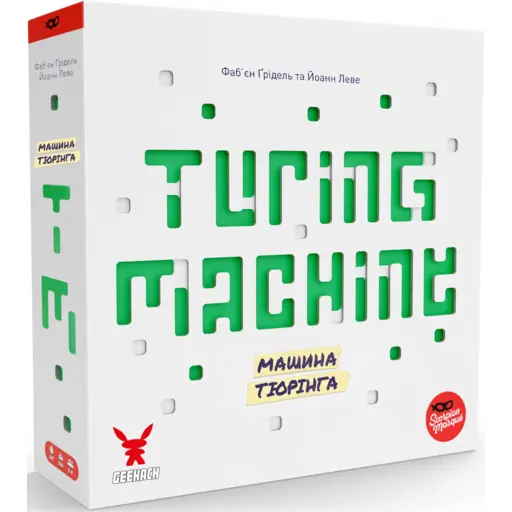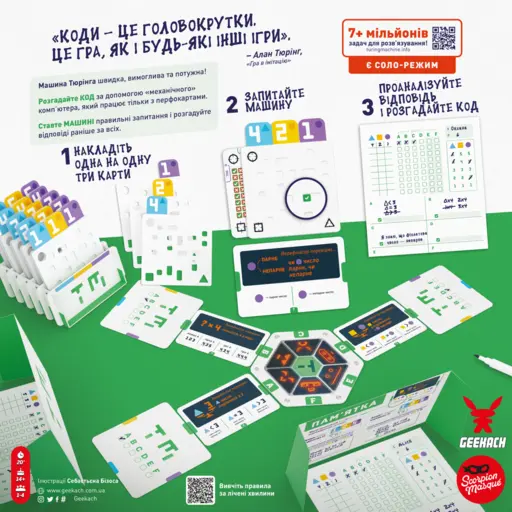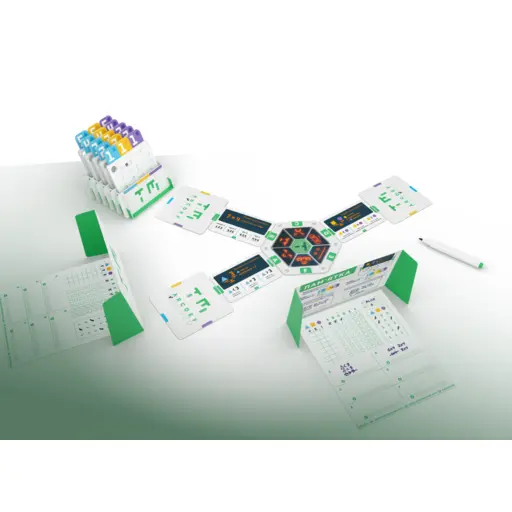Board Game Turing Machine
Analog Desktop Computer
Alan Turing was a prominent English mathematician whose algorithm helped break the most secure encryption machine of its time, the German «Enigma», which protected important messages from the Axis armies to the Allies during World War II. Turing said that every code is a real game, and was one of the first developers of the analog computer. So the designers of the board game not only created a real analog computer from cardboard punched cards, but also invite you to solve over 7 million codes, available both in the base game and in the companion app!
Game features
- An incredible puzzle. This is not just a math game, it is a real deductive puzzle in which you will find the correct numbers of the code using the method of exclusion and assumptions.
- Companion app and huge variability. In addition to the codes from the rulebook, the game also has a companion app containing over 7 million new codes and daily challenges that will diversify your playthroughs and allow you to compete with players from all over the world for a new record.
- Analog computer punch cards. You will assemble an analog computer (verifier) from special cards with numbers that you believe contain the code. In turn, a task card with "yes" and "no" answers will answer your questions about these numbers to suggest a path to solving the cipher.
- Solo, cooperative and competitive game modes. Play alone against complex ciphers, challenging yourself and the in-app leaderboards, solve codes together with friends or compete in the speed of finding the correct combination.
Game flow
First, choose a code and select the necessary cards according to the task - verification cards and computer answer cards to them. Lay them out in the center of the table according to the task instructions around the verifier tile, and place the perforated cards on the stand.
Each participant also receives a pencil and a notepad, which also serves as a screen to hide their guesses from the rest of the participants. Players also receive a sheet of notes to write down guesses - this should be covered with a screen.
So, now you are ready to play!
All players will walk at the same time during the round, trying to solve the code. A round will always consist of several phases:
- Form a proposal. Make a guess about the three digits of the code, take the perforated cards with the numbers of your guess and assemble an analog computer from them.
- Ask the machine. With the same set of punch cards, you can check up to 3 verifier cards during one round. Choose a verifier and check whether the statement on it is true according to your assumption and the code from the task: place the card under your analog computer and you will see a red "failure" or a green "success" in one of the windows. Write down the new information and cross out the unsuitable number options on your notepad - this is mandatory, as you will also need it at the end of the game.
- Analyze the answer. Try to put together the puzzle of this task from all the answers received. Now you can decide whether you have already solved the code.
- End of the round. In this phase, all players hold out their fists in front of them. Count to three, and on the count of "three" all players should point their thumbs down if they think they have not yet solved the code, and up if they think they have already cracked the cipher.
Ending the game and determining the winners
If at least one player has pointed up, the game ends and the participants have one last chance to check their guesses - to secretly and clearly write the latest version of the code on their letters, and check it in the solutions at the end of the rule booklet, or by clicking the button in the application.
If only one participant has solved the code, he becomes the winner, and if there are several such players, they must compare the number of verifications they used during the game. In this case, the winner is the participant who asked the fewest questions.
Publisher: Geekach
Language: Ukrainian
Players: 1-4
Play time: 20 m
Age: 14+
- 45 punch cards
- 4 landmarks
- machine tile
- 48 criteria cards
- 95 verification cards
- marker
- game rules




